Decoding China’s Smart Forestry Policies: A Multi-Level Evaluation via LDA and PMC-TE Index
Abstract
1. Introduction
1.1. Background
1.2. Literature Review
1.2.1. Research on Smart Forestry
1.2.2. Policy Evaluation Methods and Analytical Tools
- (i)
- Causal Inference and Empirical Evaluation
- (ii)
- Policy Text Analysis and Structure Modeling
- (iii)
- Policy Instrument Typologies and Governance Logic
1.2.3. Remaining Gaps in the Literature
1.3. Research Objectives and Contribution
- (i)
- Theoretically, this study contributes to the ongoing shift from outcome-based to structure-oriented policy analysis, enriching the understanding of how digital governance logics are embedded in multi-level smart forestry policy design.
- (ii)
- Methodologically, it builds a replicable and scalable framework integrating textual analysis, instrument classification, and coherence modeling for complex environmental policy.
- (iii)
- Practically, it delivers empirical insights into the structural configuration and underlying logic of smart forestry policies and offers a transferable framework for improving policy coherence in other national and regional contexts undergoing digital transformation in environmental governance.
2. Materials and Methods
2.1. Data Collection and Preprocessing
2.1.1. Data Collection
2.1.2. Text Preprocessing
2.2. Identification of Policy Themes
2.2.1. LDA Topic Modeling Approach
- Topic Coherence: This measures the co-occurrence of keywords within each topic, reflecting the semantic coherence of the topic. Higher values indicate tighter semantic cohesion within the topic. This study used the c_v metric for calculation.
- Perplexity: This measures the model’s ability to predict unseen documents. A lower value indicates a stronger ability to generalize. This study used log-perplexity for measurement.
- Kullback–Leibler divergence (KL divergence): It measures the deviation between the average topic distribution learned by the model and the theoretical uniform distribution, reflecting topic distinctiveness.
- Jensen–Shannon divergence (JSD): A symmetric improvement of KL divergence that is used to assess the balance and separability of the overall topic distribution. Values range from 0 to 1.
2.2.2. Topic Identification and Policy Selection
2.3. Analysis of Policy Instruments
2.4. Quantification of Policy Effectiveness
- (i)
- Constructing the multi-input–output matrix based on the variable indicator system;
- (ii)
- Categorizing variables and assigning values to corresponding parameters;
- (iii)
- Calculating the PMC index through standardized scoring rules;
- (iv)
- Visualizing the results through the construction of the PMC surface.
2.4.1. Classification of Variables and Identification of Parameters
2.4.2. Construction of the Multi-Input–Output Matrix
2.4.3. Measurement of the PMC Index
- (i)
- Input the 9 main variables and 32 sub-variables into the multi-input–output matrix.
- (ii)
- Evaluate sub-variable by sub-variable according to the parameters mentioned above (see Expressions (1) and (2)).
- (iii)
- Calculate the value of each main variable by averaging the scores of its sub-variables (see Expression (3)).
- (iv)
- Measure the PMC index by summing the values of all main variables (see Expression (4)).
2.4.4. Construction of the PMC Surface
3. Results
3.1. Topic Modeling of Smart Forestry Policies
3.2. Typological Classification of Smart Forestry Policy Instruments
- (i)
- Supply-side instruments: Seven themes primarily encompass technical support and digital infrastructure. These instruments reflect direct governmental investment in areas such as funding, platforms, and technology. Representative themes include forestry technology and germplasm innovation, intelligent sensing and monitoring support, and digital economy and infrastructure development.
- (ii)
- Demand-side instruments: Two themes emphasize the enhancement of public services and the empowerment of rural sectors, focusing on service accessibility and livelihood support. Representative themes include digital circulation and livelihood services and rural industry and agricultural empowerment.
- (iii)
- Environmental instruments: Four themes focus on ecological norms, institutional mechanisms, and governance coordination. Examples include forest supervision and data governance, policy coordination and mobilization mechanisms, and ecological governance and disaster control.
3.3. Structural Consistency and Coherence Evaluation Based on the PMC-TE Model
3.3.1. Overall Evaluation of PMC-TE Scores
- Seven policies (approximately 27%) rated as ‘Perfect’, demonstrating high structural integrity and coordination;
- Nine policies (approximately 35%) were rated as ‘Excellent’, performing well in most secondary indicators.
- Seven policies (approximately 27%) were rated as ‘Average’, with certain dimensions lacking completeness or coordination.
- Three policies (approximately 11%) were classified as ‘Acceptable’, exhibiting a weak overall structure with noticeable logical gaps and missing elements.
3.3.2. Structural Heterogeneity Analysis
4. Discussion
4.1. Strategic Priorities and Policy Instrument Balance
- (i)
- Enhance demand-side participation. Introduce incentive mechanisms that encourage local governments, rural entities, and forestry cooperatives to participate actively in smart forestry development.
- (ii)
- Strengthen the closed-loop logic between tools. Use ecological indicators to connect platform construction, monitoring data, and feedback mechanisms to achieve a closed-loop governance system of “goal-execution-feedback.”
- (iii)
- Promote the construction of institutionalized coordination mechanisms. Learn from the EU’s cross-departmental coordination experience to establish a joint forestry policy or information-sharing mechanism that reduces departmental barriers.
4.2. Practical Meaning of Structural Coherence
- (i)
- Establish a closed-loop feedback structure that connects planning, implementation, and evaluation.
- (ii)
- Strengthen resilience through coherent time design and stakeholder adaptability.
- (iii)
- Promote modular and participatory tool configuration to enhance system responsiveness.
5. Conclusions
5.1. Research Conclusions
5.2. Marginal Contributions
5.3. Research Limitations and Future Prospects
Author Contributions
Funding
Data Availability Statement
Conflicts of Interest
Appendix A
| Topic ID | Category | Region | Policy Document Title | Document Issuance Number | Release Date |
|---|---|---|---|---|---|
| 1 | Supply-side instruments | Jilin | Jilin Province Digital Agriculture Development “14th Five-Year Plan” (2021-2025) | JNongShiFa (2021) No. 9 | 13 May 2021 |
| Jilin | Implementation Opinions of the General Office of Jilin Provincial People’s Government on Smart Agriculture Development | JZhengBanFa (2022) No. 34 | 8 October 2022 | ||
| 2 | Supply-side instruments | Central | Guiding Opinions on Promoting the Development of China Forestry Cloud | LinXinFa (2017) No. 116 | 25 October 2017 |
| Central | National Forestry Informatization Construction Technical Guide | LinBanFa (2009) No. 23 | 1 February 2009 | ||
| 3 | Demand-side instruments | Central | “14th Five-Year Plan” Forestry and Grassland Protection Development Plan Outline | LinGuiFa (2021) No. 108 | 14 December 2021 |
| Central | Guiding Opinions of the National Forestry and Grassland Administration on Promoting High-Quality Development of Forestry and Grassland Industries | LinGaiFa (2019) No. 14 | 19 February 2019 | ||
| 4 | Environment-type instruments | Central | “Internet Plus” Forestry Action Plan—National Forestry Informatization “13th Five-Year” Development Plan | LinGuiFa (2016) No. 116 | 22 March 2016 |
| Central | National Forestry Informatization Development “12th Five-Year” Plan | LinGuiFa (2011) No. 183 | 30 November 2011 | ||
| 5 | Supply-side instruments | Fujian | Construction Plan for Six Service Platforms for High-Quality Forestry Development | MinLinWen (2024) No. 77 | 26 August 2024 |
| Fujian | Fujian Province Implementation Plan for Comprehensively Accelerating Digital Empowerment of High-Quality Economic and Social Development | MinZheng (2025) No. 4 | 18 February 2025 | ||
| 6 | Environment-type instruments | Heilongjiang | Heilongjiang Province Grassland Ecological Protection, Restoration and Utilization Plan | HeiLinCaoFa (2021) No. 63 | 15 November 2021 |
| Jilin | Beautiful Jilin Construction Action Plan (2024–2027) | JZhengBanFa (2024) No. 21 | 11 December 2024 | ||
| 7 | Environment-type instruments | Jilin | Jilin Province Pilot Scheme for Establishing Modern State-Owned Forest Farms | JiLinLianFa (2020) No. 26 | 18 September 2020 |
| Heilongjiang | 2020 Central Budget Investment Plan for Grassland Fire Prevention Projects | HeiLinCaoGui (2020) No. 12 | 26 April 2020 | ||
| 8 | Environment-type instruments | Central | Forestry Development “13th Five-Year” Plan | LinGuiFa (2016) No. 60 | 6 May 2016 |
| Central | Typical Cases of Forestry Reform and Development in Fujian Province (Second Batch) | MinLinWen (2024) No. 47 | 7 June 2024 | ||
| 9 | Supply-side instruments | Heilongjiang | Heilongjiang Province Digital Forestry and Grassland Construction Plan (2018–2025)–Ecological System Chapter | HeiZhengBanGui (2018) No. 3 | 1 December 2018 |
| Heilongjiang | Heilongjiang Province Digital Forestry and Grassland Construction Plan (2018–2025) | HeiZhengBanGui (2018) No. 3 | 1 December 2018 | ||
| 10 | Supply-side instruments | Heilongjiang | Heilongjiang Province “14th Five-Year” Digital Economy Development Plan | HeiZhengFa (2022) No. 9 | 22 March 2022 |
| Fujian | 2023 Key Tasks for Digital Fujian Construction | MinZhengBan (2023) No. 16 | 22 May 2023 | ||
| 11 | Demand-side instruments | Jilin | Jilin Province Big Data Regulations | Jilin Province 13th People’s Congress Standing Committee Announcement No. 25 | 27 November 2020 |
| Heilongjiang | Heilongjiang Province Regulations on Promoting Big Data Development and Application | Heilongjiang Province 13th People’s Congress Standing Committee Announcement No. 33 | 1 July 2022 | ||
| 12 | Environment-type instruments | Heilongjiang | Heilongjiang Province Digital Forestry and Grassland Construction Plan (2018–2025)–Supervision System Chapter | HeiZhengBanGui (2018) No. 3 | 1 December 2018 |
| Heilongjiang | Heilongjiang Province Interim Measures for Satellite Remote Sensing Monitoring of Forestry and Grassland Resources | HeiLinCaoFa (2020) No. 10 | 25 February 2020 | ||
| 13 | Supply-side instruments | Heilongjiang | 2021 Heilongjiang Province Forest Supervision and “One Map” Annual Update Work Plan for Forest Resource Management | HeiLinCaoFa (2021) No. 25 | 22 April 2021 |
| Heilongjiang | Work Plan for Satellite Remote Sensing Monitoring of Forestry and Grassland Resources | HeiLinCaoFa (2022) No. 08 | 12 April 2022 |
References
- Arts, K.; Van der Wal, R.; Adams, W.M. Digital technology and the conservation of nature. Ambio 2015, 44, 661–673. [Google Scholar] [CrossRef]
- Gabrys, J. Smart forests and data practices: From the Internet of Trees to planetary governance. Big Data Soc. 2020, 7, 2053951720904871. [Google Scholar] [CrossRef]
- Gabrys, J.; Westerlaken, M.; Urzedo, D.; Ritts, M.; Simlai, T. Reworking the political in digital forests: The cosmopolitics of sociotechnical worlds. Prog. Environ. Geogr. 2022, 1, 58–83. [Google Scholar] [CrossRef]
- Hou, R.; Ma, G.; Tong, L. How policy instruments affect forest cover: Evidence from China. For. Policy Econ. 2025, 172, 103455. [Google Scholar] [CrossRef]
- Layani, G.; Mehrjou, S.; Farajzadeh, Z. Effects of government policies reform on environmental sustainability: An integrated approach of PMP and system dynamics simulation model. J. Clean. Prod. 2023, 426, 138985. [Google Scholar] [CrossRef]
- Singh, R.; Gehlot, A.; Akram, S.V.; Thakur, A.K.; Buddhi, D.; Das, P.K. Forest 4.0: Digitalization of forest using the Internet of Things (IoT). J. King Saud Univ.-Comput. Inf. Sci. 2022, 34, 5587–5601. [Google Scholar] [CrossRef]
- Wang, G.G.; Lu, D.; Gao, T.; Zhang, J.; Sun, Y.; Teng, D.; Yu, F.; Zhu, J. Climate-smart forestry: An AI-enabled sustainable forest management solution for climate change adaptation and mitigation. J. For. Res. 2024, 36, 7. [Google Scholar] [CrossRef]
- Padilla, E.C.; Giuliani, A.; Kanniya, K.S.; Heang, V.L.; Sokchea, T.; Hou, K.; Gilliéron, J. Community engagement in the governance of Cambodian recreation forests. For. Policy Econ. 2025, 170, 103386. [Google Scholar] [CrossRef]
- Himes, A.; Hayes, P.; Jansens, J.-W.; Patterson, C.; Singer, J.; Evans, Z. Forest Stewards Guild position on climate-smart forestry. For. Monit. 2024, 1, 1–15. [Google Scholar] [CrossRef]
- Nijnik, M.; Secco, L.; Miller, D.; Melnykovych, M. Can social innovation make a difference to forest-dependent communities? For. Policy Econ. 2019, 100, 207–213. [Google Scholar] [CrossRef]
- Ludvig, A.; Weiss, G.; Sarkki, S.; Nijnik, M.; Živojinović, I. Mapping European and forest related policies supporting social innovation for rural settings. For. Policy Econ. 2018, 97, 146–152. [Google Scholar] [CrossRef]
- Brnkalakova, S.; Melnykovych, M.; Nijnik, M.; Barlagne, C.; Pavelka, M.; Udovc, A.; Marek, M.; Kovac, U.; Kluvánková, T. Collective forestry regimes to enhance transition to climate smart forestry. Environ. Policy Gov. 2022, 32, 492–503. [Google Scholar] [CrossRef]
- Alfieri, D.; Tognetti, R.; Santopuoli, G. Exploring climate-smart forestry in Mediterranean forests through an innovative composite climate-smart index. J. Environ. Manag. 2024, 368, 122002. [Google Scholar] [CrossRef]
- Ludvig, A.; Sarkki, S.; Weiss, G.; Živojinović, I. Policy impacts on social innovation in forestry and back: Institutional change as a driver and outcome. For. Policy Econ. 2021, 122, 102335. [Google Scholar] [CrossRef]
- Ehrlich-Sommer, F.; Hoenigsberger, F.; Gollob, C.; Nothdurft, A.; Stampfer, K.; Holzinger, A. Sensors for digital transformation in smart forestry. Sensors 2024, 24, 798. [Google Scholar] [CrossRef] [PubMed]
- Hoppen, M.; Chen, J.; Kemmerer, J.; Baier, S.; Bektas, A.R.; Schreiber, L.J.; Mayer, D.G.; Kaulen, A.; Ziesak, M.; Rossmann, J. Smart forestry—A forestry 4.0 approach to intelligent and fully integrated timber harvesting. Int. J. For. Eng. 2024, 35, 137–152. [Google Scholar] [CrossRef]
- Meng, G.; Wu, S.; Yu, Y. Forestry policy effectiveness and performance evaluation in China—Quantitative study based on policy texts 1998–2020. For. Policy Econ. 2025, 170, 103367. [Google Scholar] [CrossRef]
- Thal, D.R.C.; Forrow, L.V.; Lipman, E.R.; Starling, J.E.; Finucane, M.M. Aggregate bayesian causal forests: The abcs of flexible causal inference for hierarchically structured data. arXiv 2024, arXiv:2407.07067. [Google Scholar] [CrossRef]
- Souto, H.G.; Neto, F.L. Forests for Differences: Robust Causal Inference Beyond Parametric DiD. arXiv 2025, arXiv:2505.09706. [Google Scholar] [CrossRef]
- Blei, D.M.; Ng, A.Y.; Jordan, M.I. Latent Dirichlet Allocation. J. Mach. Learn. Res. 2003, 3, 993–1022. [Google Scholar]
- Blackman, A. Evaluating forest conservation policies in developing countries using remote sensing data: An introduction and practical guide. For. Policy Econ. 2013, 34, 1–16. [Google Scholar] [CrossRef]
- Sarker, P.K.; Fischer, R.; Tamayo, F.; Navarrete, B.T.; Günter, S. Analyzing forest policy mixes based on the coherence of policies and the consistency of legislative policy instruments: A case study from Ecuador. For. Policy Econ. 2022, 144, 102838. [Google Scholar] [CrossRef]
- Chen, X.; Lin, B. Towards carbon neutrality by implementing carbon emissions trading scheme: Policy evaluation in China. Energy Policy 2021, 157, 112510. [Google Scholar] [CrossRef]
- Elomina, J.; Pülzl, H. How are forests framed? An analysis of EU forest policy. For. Policy Econ. 2021, 127, 102448. [Google Scholar] [CrossRef]
- Aurenhammer, P.K.; Glormann, M.; Strüber, P.; Krott, M. The relevance of social-milieus for forest policy research—Insights from a Germany-focused review. Trees For. People 2025, 20, 100866. [Google Scholar] [CrossRef]
- Vatn, A. Rationality, institutions and environmental policy. Ecol. Econ. 2005, 55, 203–217. [Google Scholar] [CrossRef]
- Howlett, M.; Rayner, J. Patching vs packaging in policy formulation: Assessing policy portfolio design. Politics Gov. 2013, 1, 170–182. [Google Scholar] [CrossRef]
- Lascoumes, P.; Le Gales, P. Introduction: Understanding public policy through its instruments—From the nature of instruments to the sociology of public policy instrumentation. Governance 2007, 20, 1–21. [Google Scholar] [CrossRef]
- Neeff, T.; Piazza, M. How countries link forest monitoring into policy-making. For. Policy Econ. 2020, 118, 102248. [Google Scholar] [CrossRef]
- Jordan, A.; Benson, D.; Wurzel, R.; Zito, A.R.; Richardson, J.J. Environmental policy: Governing by multiple policy instruments. In Constructing a Policy-Making State? Oxford University Press: Oxford, UK, 2012; pp. 104–124. [Google Scholar]
- Lockie, S. Market instruments, ecosystem services, and property rights: Assumptions and conditions for sustained social and ecological benefits. Land Use Policy 2013, 31, 90–98. [Google Scholar] [CrossRef]
- Blackstock, K.L.; Novo, P.; Byg, A.; Creaney, R.; Bourke, A.J.; Maxwell, J.L.; Tindale, S.J.; Waylen, K.A. Policy instruments for environmental public goods: Interdependencies and hybridity. Land Use Policy 2021, 107, 104709. [Google Scholar] [CrossRef]
- Cubbage, F.; Harou, P.; Sills, E. Policy instruments to enhance multi-functional forest management. For. Policy Econ. 2007, 9, 833–851. [Google Scholar] [CrossRef]
- Barton, D.N.; Ring, I.; Rusch, G.M. Policy Mixes: Aligning instruments for biodiversity conservation and ecosystem service provision. Environ. Policy Gov. 2017, 27, 397–403. [Google Scholar] [CrossRef]
- Shan, B.; Li, F. A Review of LDA-based Topic Evolution Research Methods. J. Chin. Inf. Process. 2010, 24, 43–49. [Google Scholar]
- Mimno, D.; Wallach, H.M.; Talley, E.; Leenders, M.; McCallum, A. Optimizing semantic coherence in topic models. In Proceedings of the Conference on Empirical Methods in Natural Language Processing, Edinburgh, UK, 27–31 July 2011; Association for Computational Linguistics: Stroudsburg, PA, USA, 2011; pp. 262–272. [Google Scholar]
- Qin, C.; Zhu, T.; Zhao, P.; Zhang, Y. Research progress in natural language semantic analysis. Libr. Inf. Serv. 2014, 58, 130–137. [Google Scholar] [CrossRef]
- Jelodar, H.; Wang, Y.; Yuan, C.; Feng, X. Latent Dirichlet allocation (LDA) and topic modeling: Models, applications, a survey. Multimed. Tools Appl. 2019, 78, 15169–15211. [Google Scholar] [CrossRef]
- Cai, Z.; Li, H.; Hu, X.; Graesser, A. Can Word Probabilities from LDA Be Simply Added up to Represent Documents? In Proceedings of the 9th International Conference on Educational Data Mining, Raleigh, NC, USA, 29 June–2 July 2016. [Google Scholar]
- Rothwell, R.; Zegveld, W. Industrial Innovation and Public Policy: Preparing for the 1980s and the 1990s; Greenwood Press: Westport, CT, USA, 1981. [Google Scholar]
- Ruiz Estrada, M.A.; Yap, S.F.; Nagaraj, S. Beyond the ceteris paribus assumption: Modeling demand and supply assuming omnia mobilis. Int. J. Econ. Res. 2008, 5, 185–194. [Google Scholar]
- Liu, Q.; Jia, M.; Xia, D. Dynamic evaluation of new energy vehicle policy based on text mining of PMC knowledge framework. J. Clean. Prod. 2023, 392, 136237. [Google Scholar] [CrossRef]
- Song, C.; Liu, Z.; Yuan, M.; Zhao, C. From text to effectiveness: Quantifying green industrial policies in China. J. Clean. Prod. 2024, 446, 141445. [Google Scholar] [CrossRef]
- Estrada, M.A.R. Policy modeling: Definition, classification and evaluation. J. Policy Model. 2011, 33, 523–536. [Google Scholar] [CrossRef]
- Dai, S.; Zhang, W.; Zong, J.; Wang, Y.; Wang, G. How effective is the green development policy of China’s Yangtze River Economic Belt? A quantitative evaluation based on the PMC-index model. Int. J. Environ. Res. Public Health 2021, 18, 7676. [Google Scholar] [CrossRef]
- Yiye, Z.; Mo, W.; Yuxiu, C.; Wenze, H. Quantitative evaluation of the civil aviation green development policy of China based on the policy modeling consistency (PMC) index model. Transp. Policy 2025, 162, 171–187. [Google Scholar] [CrossRef]
- Chuang, J.; Manning, C.D.; Heer, J. Termite: Visualization techniques for assessing textual topic models. In Proceedings of the International Working Conference on Advanced Visual Interfaces, Capri Island, Italy, 21–25 May 2012; pp. 74–77. [Google Scholar]
- Sievert, C.; Shirley, K. LDAvis: A method for visualizing and interpreting topics. In Proceedings of the Workshop on Interactive Language Learning, Visualization, and Interfaces, Baltimore, MD, USA, 27 June 2014; pp. 63–70. [Google Scholar]
- Howlett, M.; Rayner, J. Design principles for policy mixes: Cohesion and coherence in ‘new governance arrangements’. Policy Soc. 2007, 26, 1–18. [Google Scholar] [CrossRef]
- Tesfaye, M.; Kimengsi, J.N.; Giessen, L. A policy mix for achieving ambitious goals on forest landscape restoration: Analyzing coherence and consistency in Ethiopia forest-related policy. Land Use Policy 2024, 144, 107214. [Google Scholar] [CrossRef]
- Ramesh, M. Studying Public Policy: Policy Cycles and Policy Subsystems; Oxford University Press: Toronto, ON, Canada, 2003. [Google Scholar]
- Rogge, K.S.; Reichardt, K. Policy mixes for sustainability transitions: An extended concept and framework for analysis. Res. Policy 2016, 45, 1620–1635. [Google Scholar] [CrossRef]
- European Commission. New EU Forest Strategy for 2030. 2021. Available online: https://ec.europa.eu/info/news (accessed on 10 June 2025).
- Van Gossum, P.; Ledene, L.; Arts, B.; De Vreese, R.; Van Langenhove, G.; Verheyen, K. New environmental policy instruments to realize forest expansion in Flanders (northern Belgium): A base for smart regulation? Land Use Policy 2009, 26, 935–946. [Google Scholar] [CrossRef]
- Capano, G.; Howlett, M. Causal logics and mechanisms in policy design: How and why adopting a mechanistic perspective can improve policy design. Public Policy Adm. 2021, 36, 141–162. [Google Scholar] [CrossRef]
- Ontario Ministry of Natural Resources and Forestry. Forest Management Planning Manual. Government of Ontario. 2021. Available online: https://files.ontario.ca/mnrf-forest-management-planning-manual-en-2021-04-09.pdf (accessed on 10 June 2025).
- Natural Resources Canada. The State of Canada’s Forests: Annual Report 2020. Government of Canada. 2020. Available online: https://natural-resources.canada.ca/our-natural-resources/forests/state-canadas-forests-report/16496 (accessed on 10 June 2025).
- Bennear, L.S.; Stavins, R.N. Second-best theory and the use of multiple policy instruments. Environ. Resour. Econ. 2007, 37, 111–129. [Google Scholar] [CrossRef]
- Hood, C.; Margetts, H. The Tools of Government in the Digital Age; Bloomsbury Publishing: London, UK, 2007. [Google Scholar]
- Kattel, R.; Mazzucato, M. Mission-oriented innovation policy and dynamic capabilities in the public sector. Ind. Corp. Change 2018, 27, 787–801. [Google Scholar] [CrossRef]
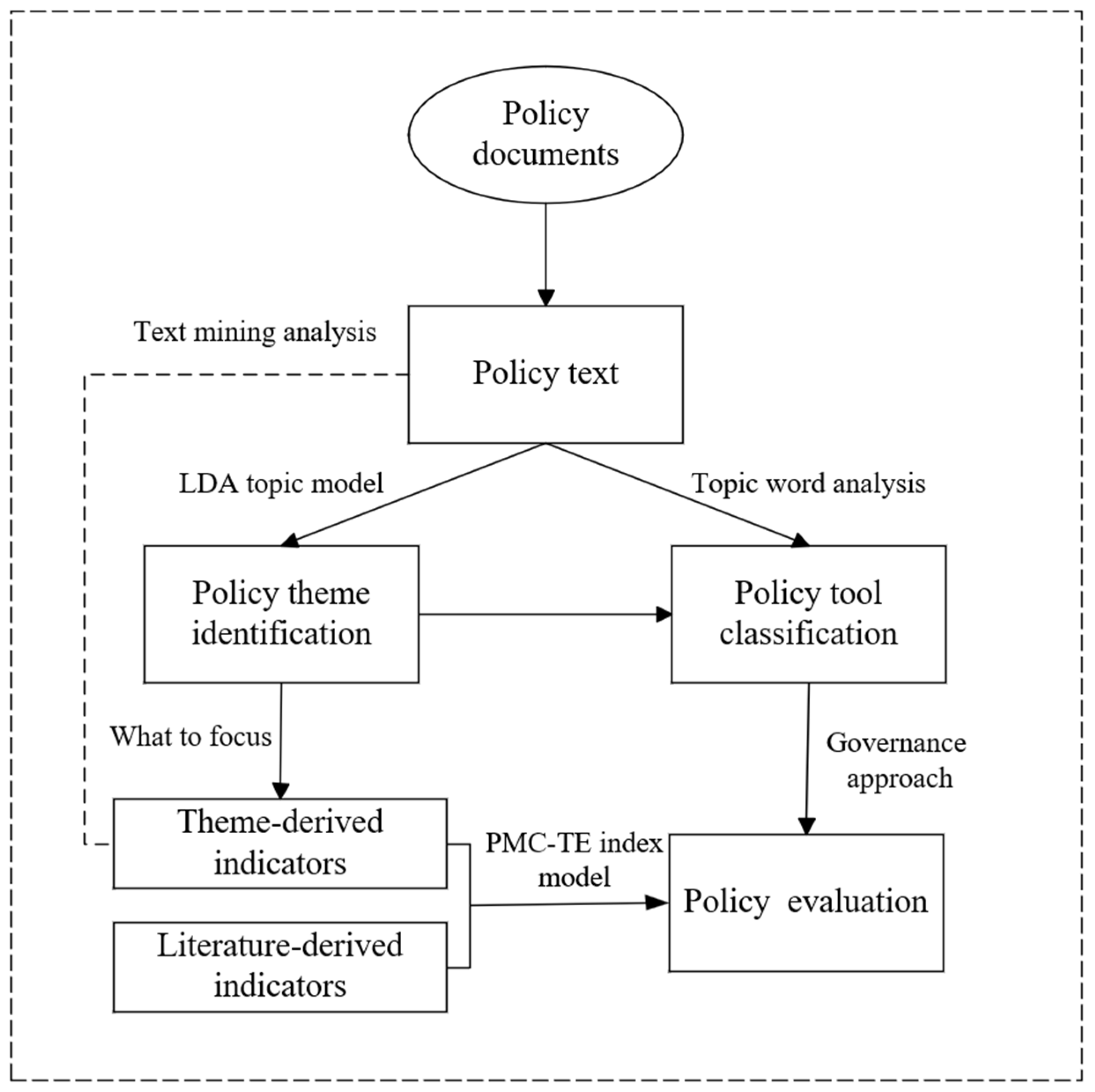
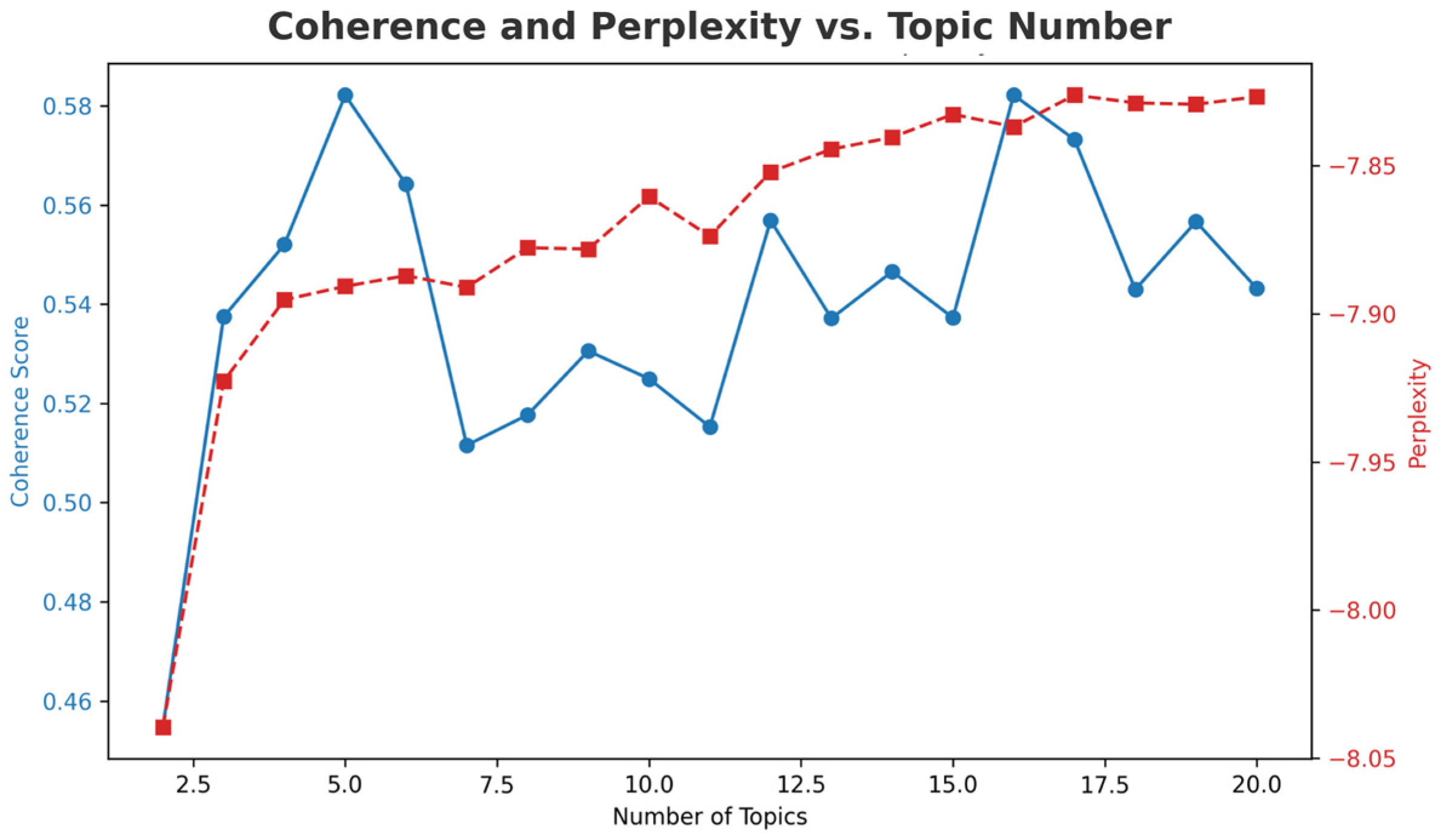
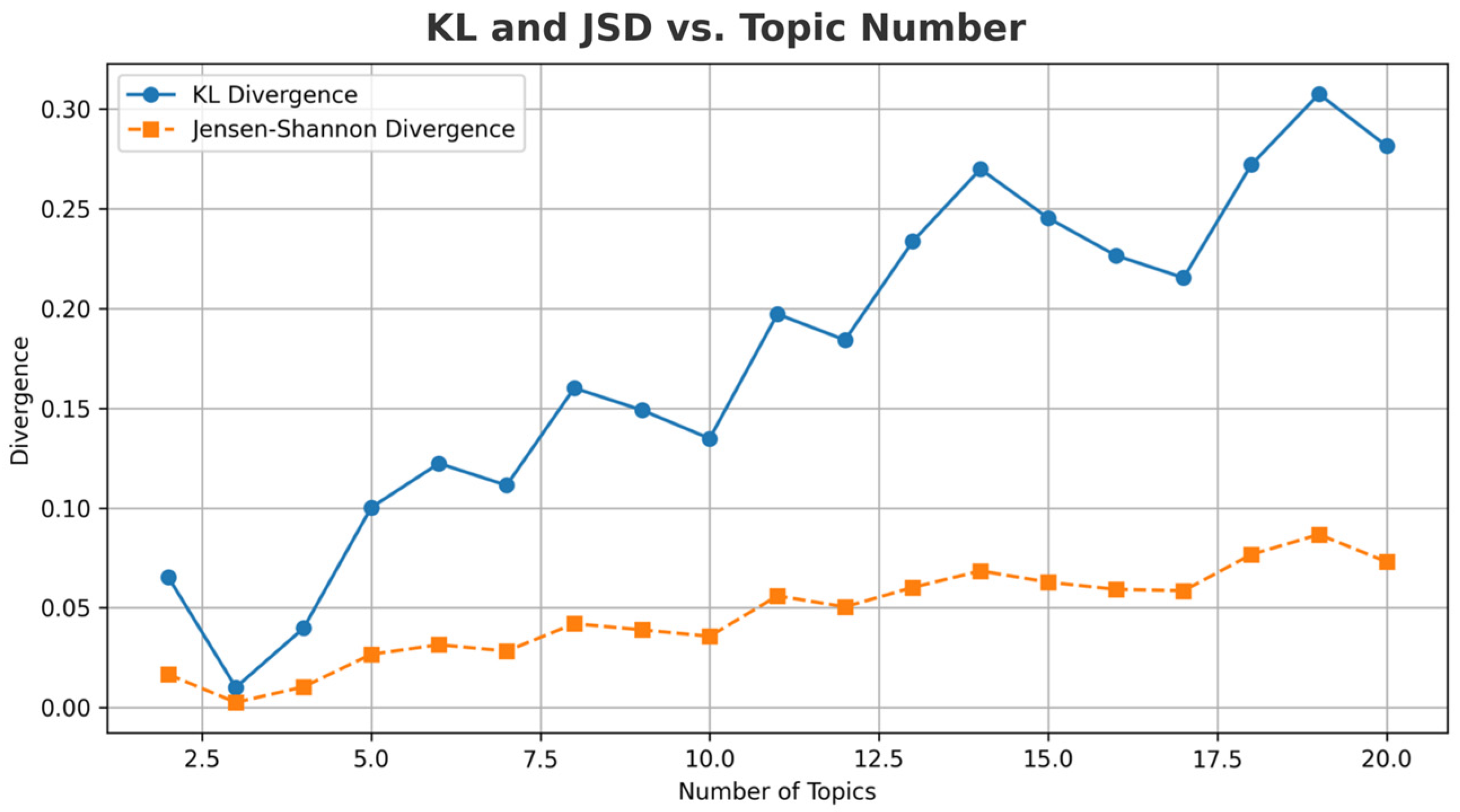
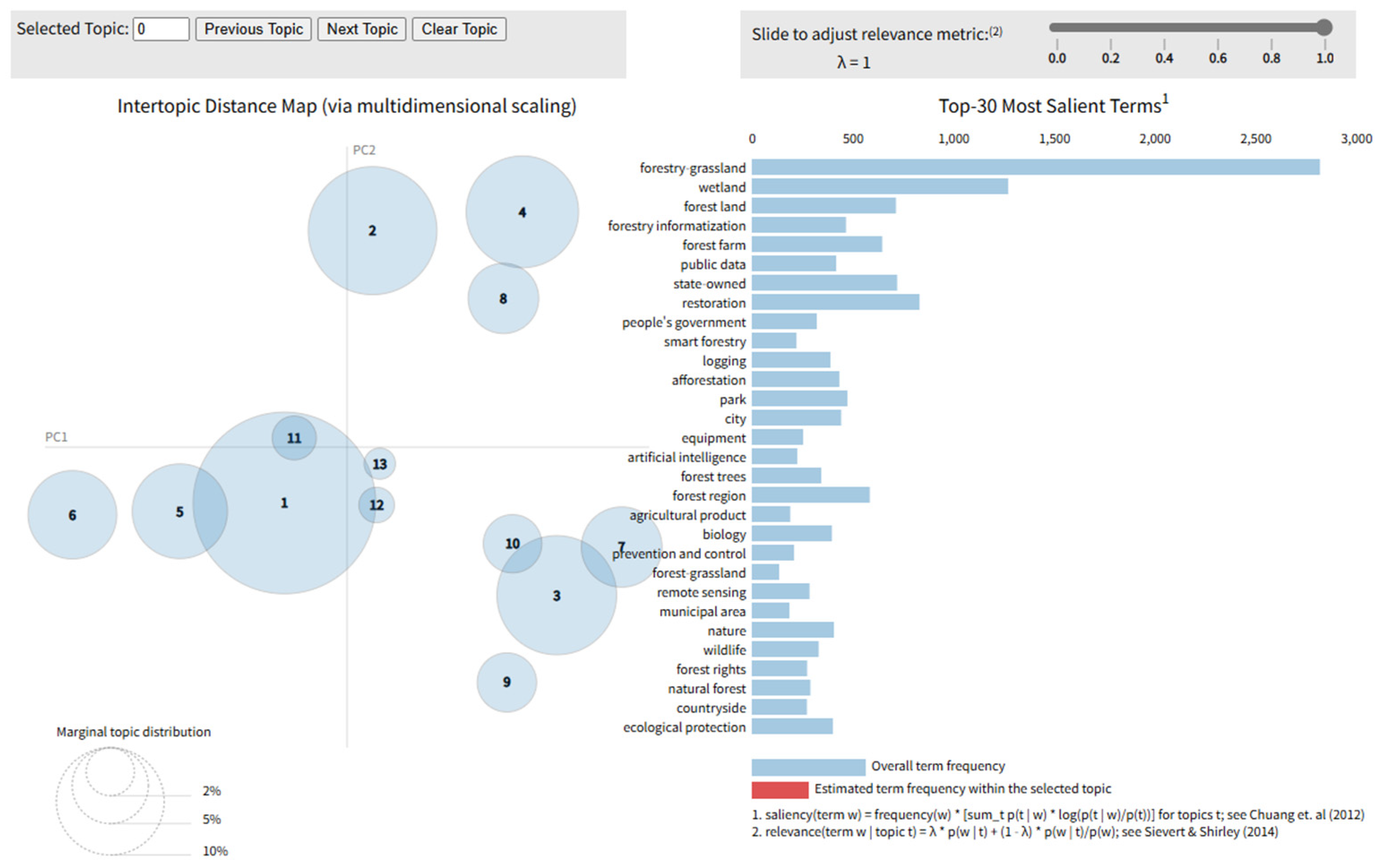

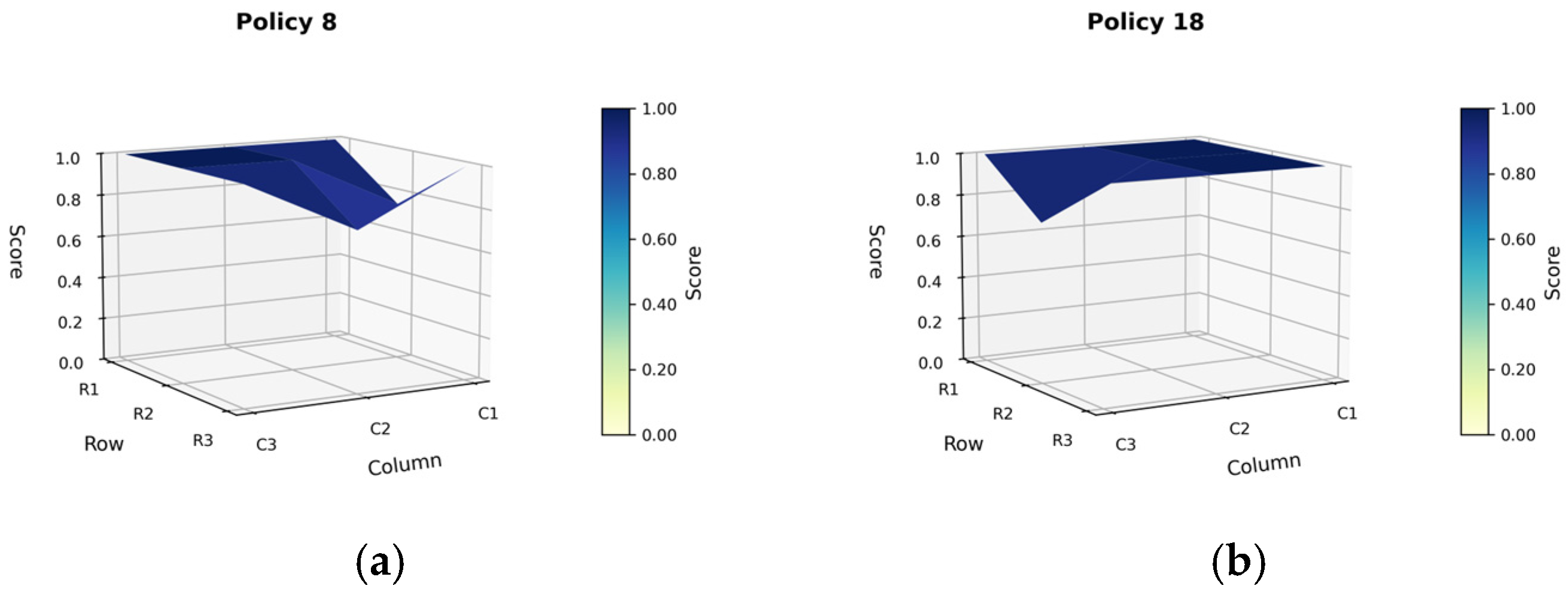

| Topic ID | Category | Region | Policy Document Title | Document Issuance Number | Release Date |
|---|---|---|---|---|---|
| 1 | Supply-side instruments | Jilin | Jilin Province Digital Agriculture Development “14th Five-Year Plan” (2021–2025) | JNongShiFa (2021) No. 9 | 13 May 2021 |
| Jilin | Implementation Opinions of the General Office of Jilin Provincial People’s Government on Smart Agriculture Development | JZhengBanFa (2022) No. 34 | 8 October 2022 | ||
| … | … | … | … | … | … |
| 13 | Supply-side instruments | Heilongjiang | 2021 Heilongjiang Province Forest Supervision and “One Map” Annual Update Work Plan for Forest Resource Management | HeiLinCaoFa (2021) No. 25 | 22 April 2021 |
| Heilongjiang | Work Plan for Satellite Remote Sensing Monitoring of Forestry and Grassland Resources | HeiLinCaoFa (2022) No. 08 | 12 April 2022 |
| First-Level Variable | Second-Level ID | English Name | Description |
|---|---|---|---|
| X1 Policy Nature | X1.1 | Predictive | Whether the policy reflects predictiveness |
| X1.2 | Regulatory | Whether the policy reflects regulatory content | |
| X1.3 | Descriptive | Whether the policy provides descriptive guidance | |
| X1.4 | Diagnostic/Advisory | Whether the policy includes diagnostic assessments or offers actionable recommendations based on prior evaluations | |
| X2 Policy Timeliness | X2.1 | Long-term | Policy duration or target period is ≥5 years |
| X2.2 | Medium-term | Policy duration or target period is between 3 and 5 years | |
| X2.3 | Short-term | Policy duration or target period is between 1 and 3 years | |
| X2.4 | Immediate/Phase | Within 1 year or a one-off work plan | |
| X3 Policy Level | X3.1 | National level | Whether the policy is issued by a national agency |
| X3.2 | Local level | Whether the policy is issued by a local agency | |
| X4 Policy Evaluation | X4.1 | Clear objectives | Whether the policy objectives are clearly stated |
| X4.2 | Substantial measures | Whether the policy provides substantial measures | |
| X4.3 | Reasonable planning | Whether the policy plan is reasonable | |
| X4.4 | Logical Coherence | A complete logical chain connecting objectives, measures, and evaluation | |
| X5 Policy domain | X5.1 | Digital Infra and Cybersecurity | Topic 2/9/13 |
| X5.2 | Ecological Protection and Restoration | Topic 4/8 | |
| X5.3 | Rural-Industry and Livelihood | Topic 3/11 | |
| X5.4 | Disaster and Risk Control | Topic 8 | |
| X6 Policy safeguards | X6.1 | Legal/Normative | Whether the policy cites laws, standards, or enforcement clauses |
| X6.2 | Funding and Talent | Special funds, talent programs, and subsidies | |
| X6.3 | Technical Support | Platforms, cloud services, AI tools | |
| X6.4 | Supervision and KPI | Dynamic monitoring, performance evaluation, third-party assessments | |
| X7 Policy priorities | X7.1 | Supply-side | Direct inputs: technology, R&D funding, infrastructure |
| X7.2 | Demand-side | Incentivizing users/markets: subsidies, demonstration consumption, etc. | |
| X7.3 | Environmental | Institutional arrangements, taxation, standard constraints | |
| X7.4 | Mixed/Pilot | Combination of the three tool types or pilot initiatives | |
| X8 Policy Targets | X8.1 | Enterprises/Market Actors | Forestry equipment providers, platform companies, etc. |
| X8.2 | Public/Farmers | Forest farmers, communities, the general public | |
| X8.3 | Governmental Bodies | Local forestry and grassland authorities | |
| X8.4 | Multi-stakeholders | Public-private partnerships, associations, social organizations | |
| X9 Policy Perspective | X9.1 | Macro Strategy | Top-level design, nationwide layout |
| X9.2 | Micro-implementation | Operational guidelines, manuals, SOPs |
| Topic ID | Topic Name | Sample Keywords | Policy Category | Type of Policy Instrument | Description |
|---|---|---|---|---|---|
| Topic 1 | Forestry Technology and Germplasm Innovation | Equipment, new varieties, science outreach, R&D | Supply-side | Technical Support | Provides research platforms, innovation conversion, and biodiversity tech/equipment support |
| Topic 2 | Smart Forestry and Information Infrastructure | Smart forestry, IT systems, cybersecurity, operation | Supply-side | Digital Infrastructure | Builds monitoring platforms, forest data systems, and IT protection layers |
| Topic 3 | Digital Circulation and Livelihood Services | Cities, logistics, e-government, public services | Demand-side | Public Service Provision | Promotes e-gov access, broadband, rural e-commerce |
| Topic 4 | Forest Ecosystem Protection and Restoration | Wetlands, rehabilitation, ecosystems, greening | Environmental | Environmental Regulation | Sets restoration targets and ecological norms |
| Topic 5 | Intelligent Sensing and Remote Monitoring Support | AI, GIS, remote sensing, surveying | Supply-side | Technical Support | Supports digital infrastructure for ecological sensing |
| Topic 6 | Forest Supervision and Data Governance | Regulation, GIS map, supervision, compliance | Environmental | Regulation and Standards | Promotes legal enforcement and data-driven governance |
| Topic 7 | Forestland Rights and Resource Allocation | Forestland, tenure, logging, ownership | Environmental | Institutional and Property Tools | Clarifies land rights, harvesting, and tenure procedures |
| Topic 8 | Ecological Governance and Disaster Control | Desertification, sand control, wildlife | Environmental | Ecological Engineering | Implements large-scale restoration and disaster mitigation |
| Topic 9 | Forest Cybersecurity and IT System Protection | Servers, threats, systems, detection | Supply-side | Infrastructure Support | Secures IT systems via hardware/software provision |
| Topic 10 | Data Statistics and Information Processing | Statistics, imagery, permissions, systems | Supply-side | Infrastructure Support | Develops geospatial/statistical processing platforms |
| Topic 11 | Rural Industry and Agricultural Empowerment | Agricultural products, cloud platform, rural economy | Demand-side | Public Service Provision | Supports farmers and value-added agriculture |
| Topic 12 | Policy Coordination and Mobilization Mechanism | NDRC, fiscal bureau, implementation coordination | Environmental | Administrative Coordination Tools | Promotes policy delivery via inter-agency collaboration |
| Topic 13 | Digital Economy and Infrastructure Development | Public data, e-commerce, computing power | Supply-side | Digital Infrastructure Support | Invests in 5G, computing, and national data hubs |
Disclaimer/Publisher’s Note: The statements, opinions and data contained in all publications are solely those of the individual author(s) and contributor(s) and not of MDPI and/or the editor(s). MDPI and/or the editor(s) disclaim responsibility for any injury to people or property resulting from any ideas, methods, instructions or products referred to in the content. |
© 2025 by the authors. Licensee MDPI, Basel, Switzerland. This article is an open access article distributed under the terms and conditions of the Creative Commons Attribution (CC BY) license (https://creativecommons.org/licenses/by/4.0/).
Share and Cite
Zhang, Y.; Ren, Y.; Liu, J.; Cao, Y. Decoding China’s Smart Forestry Policies: A Multi-Level Evaluation via LDA and PMC-TE Index. Forests 2025, 16, 1297. https://doi.org/10.3390/f16081297
Zhang Y, Ren Y, Liu J, Cao Y. Decoding China’s Smart Forestry Policies: A Multi-Level Evaluation via LDA and PMC-TE Index. Forests. 2025; 16(8):1297. https://doi.org/10.3390/f16081297
Chicago/Turabian StyleZhang, Yafang, Yue Ren, Jiaqi Liu, and Yukun Cao. 2025. "Decoding China’s Smart Forestry Policies: A Multi-Level Evaluation via LDA and PMC-TE Index" Forests 16, no. 8: 1297. https://doi.org/10.3390/f16081297
APA StyleZhang, Y., Ren, Y., Liu, J., & Cao, Y. (2025). Decoding China’s Smart Forestry Policies: A Multi-Level Evaluation via LDA and PMC-TE Index. Forests, 16(8), 1297. https://doi.org/10.3390/f16081297






